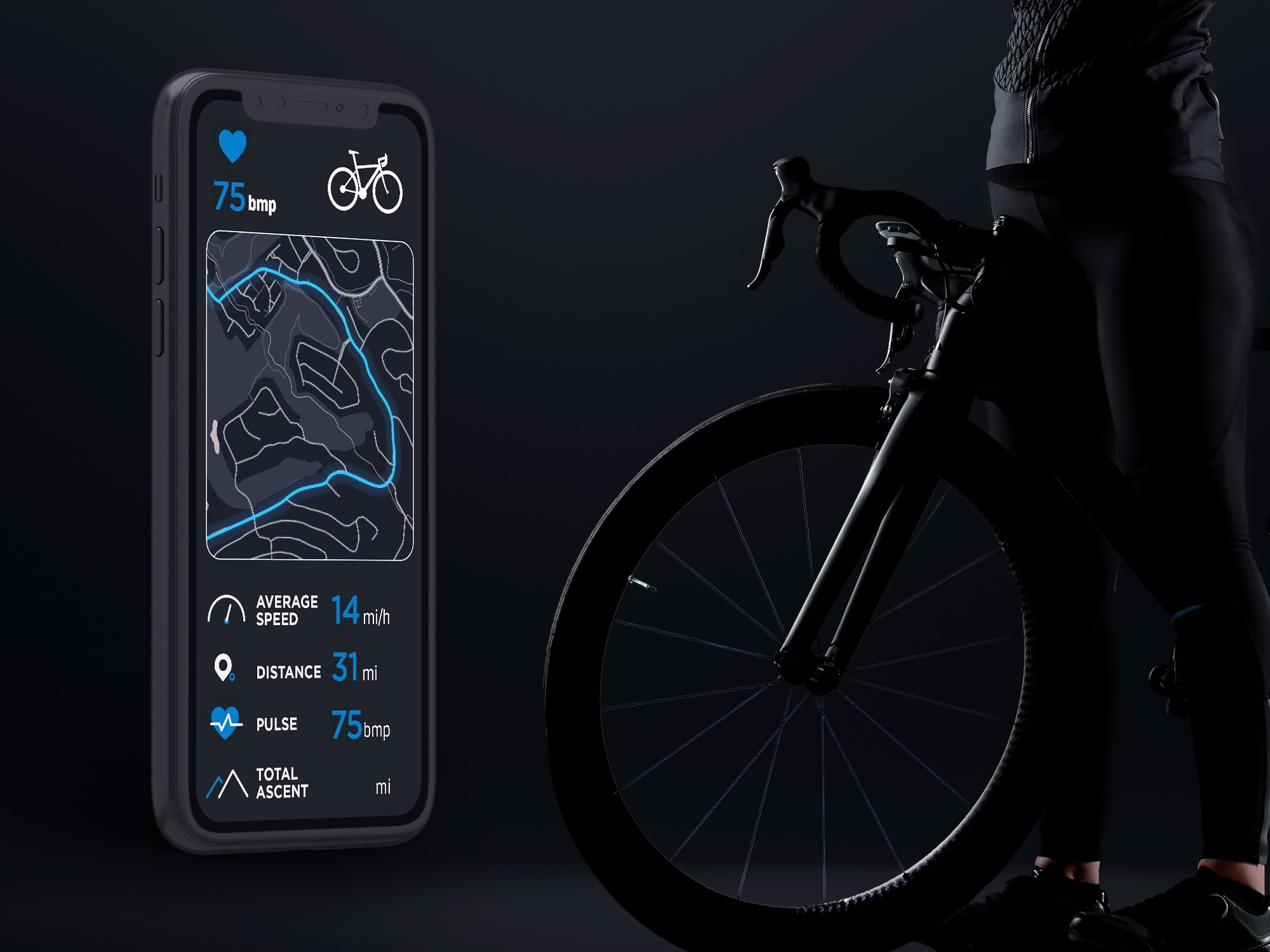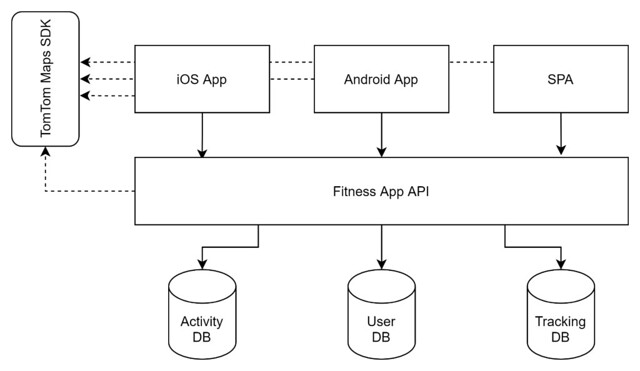How to Architect a Fitness Tracker App with TomTom Maps
)

Have you considered building a fitness app but don't know what's involved? This article helps you understand, at a high level, what goes into building out a fitness tracker app and how you can use TomTom’s APIs to do so quickly. Read on to get inspired.
You probably use — or are at least familiar with — fitness tracking apps like Strava and RunKeeper. But what would it take to build one?
In this article, you’ll learn about the front and back-end architecture for creating such an app. The architectural description is of design decisions and API-related options at a high level. You’ll also discover how TomTom APIs can help you create applications based on this architecture more quickly.
You’ll need to start with the essential requirements, like below.
Defining Requirements
Before you can start to think about technical details, such as your application’s overall architecture, you need to know what your application should include. This process is a requirements analysis, defining what you should and shouldn’t have.
The chances are high that the requirement’s scope is too large at first, so you’ll want to use a framework such as “MoSCoW” to classify the criteria:
Must: These are features that you want to have in any release of your application. They’re already part of the minimal viable product (MVP) that you want to ship.
Should: These are features that should be in your application release. They don’t necessarily need to be a part of the MVP, but they should come soon.
Could: These are features that you could choose to include later. Quite often, the decision to implement them depends on user adoption and demand. First, you should establish a user base, then determine what you need to keep those users and grow your base. Maybe the “could” features come in handy later for user retention and expansion.
Won’t: These are features that you intentionally don’t pursue. They might be too complex or conflict with the other “must” or “should” feature categories.
Sketching the Architecture
When you’ve defined all requirements, it’s time to get technical. Depending on your application’s needs, the map may be the central component or just another control that comes in handy. In any case, it makes sense to divide the application into the following parts:
Frontend (user-facing apps, such as mobile apps or a web application usually delivered as a single-page application)
Backend (the API the user-facing apps use)
Data storage and third-party services (the secret ingredient your backend data operates on)
This separation is one of the basic tenets of architecting modern mobile applications. Testing and debugging become easier and more manageable, and multiple apps can use the same data source. You can swap out, improve, or scale the data storage as you need.
It’s crucial to note the proper data storage technology selection. It could be that you should use multiple database technologies. Quite often, contents such as classical user data (for example, a user’s profile) are well-structured and might be best represented in classical SQL. Examples include MySQL or PostgreSQL.
Then, you need to consider a user’s activity, which varies in structure, depending on the activity type. For such data structures, NoSQL is best suited. One possible implementation is MongoDB. Finally, you can collect time-series information such as tracking information in a distributed column-oriented data storage facility. There are many options to choose from, including Apache Cassandra.

Since the API layer uses storage exclusively, you can also start with a single technology then refine it as you go. Choosing an approach that you can scale is critical.
If you look closely at the architecture diagram, you’ll see that the backend also communicates with the TomTom Maps SDK. This setup is because some features like route planning might be helpful to abstract from the fitness application’s API.
Building What Users Want
Users of modern fitness tracking apps expect more than just a boring list of time and distance traveled. At a minimum, they hope to see a map showing their current location and where they have been. It should show running, walking, and cycling routes. And it should provide the ability to plan fitness routes.
Once you have correctly stored the necessary geolocation coordinates, you can make maps showing these locations using the TomTom Maps SDK. And, these maps will work in native applications on Android, iOS, and web apps.
With TomTom Maps SDK, you can show stats about the portion of the route that a user has completed so far. You can display a user’s tracks with custom markers and colors that indicate which trails they followed with their bicycle, where they’ve been running, and where they walked. You can also enable users to find routes to follow when they are already out biking, running, or walking. They can take a recommended course or choose any other path depending on personal preferences, which is especially helpful for cycling.
You can architect an even richer experience for your app users. You can create a fitness dashboard that users load onto their desktop or laptop. On the dashboard, users perform actions like overlay and compare multiple workout routes on the same map to understand how their fitness habits have changed over time.
You can also use TomTom Maps SDK to enhance a user’s ability to plan routes. By enabling users to add waypoints to a map, they can thoughtfully plan a path to ensure they hit their fitness goals. For example, a runner may want to ensure their run is a minimum of five kilometers long and routes through at least one park. Using TomTom Maps APIs, you can show the user this app-calculated information in real-time as they add new waypoints, so they’ll know when they’re ready to finalize the route. Then, when the route is complete, you can overlay the entire course on the map and even color-code route segments to represent elevation changes.
You can build route sharing into your app, too. When your users find a particularly challenging or scenic route, they can share it with friends to join in next time or with others in your app’s community seeking a new running route.
Additionally, you can use the TomTom Maps API to support features like multi-day cycling routes, with waypoints for each night’s accommodation. Users can derive the pathways between these waypoints automatically. And, with real-time updates, the app provides the estimated altitude and the start and end times. This information gives the user a good idea of how challenging the route will be.
Adding Features to Enhance User Experience
Using TomTom’s APIs on the server-side, you can architect your application’s minimum functionality to provide more than users think they want. For example, you can use the Search API to automatically look up landmarks or other points of interest along a user’s route. You can also use the APIs to help automatically generate friendly workout descriptions, like “Tuesday run past Baker’s Ice Cream Shop and through Central Park.”
There’s also the possibility of offering AI-guided recommendations. After all, these tips might be a great selling point for your application. You can derive recommendations from workout patterns or use AI to find and present new suggestions based on those patterns.
Conclusion
Architecting a fitness application is complex. You need to consider many factors, like your app’s competition, what your users want from a fitness application, ease of use, and accuracy.
Using the TomTom Maps SDK, you can get a head start and focus on the aspects that make your application unique. Don’t waste time cobbling together second-tier map controls without backend APIs in your application. Give your project a rocket boost by integrating the TomTom Maps SDK for mobile or web into your user-facing apps.
Sign up today and check out what the TomTom Maps SDK can do for you and your application.
To learn more, check out our tutorial Fitness Mapping with the Strava API and TomTom Maps.
Happy mapping!